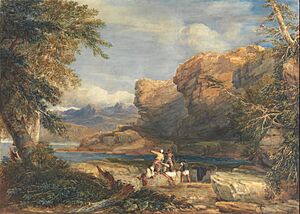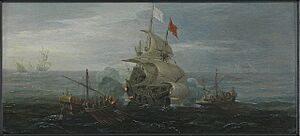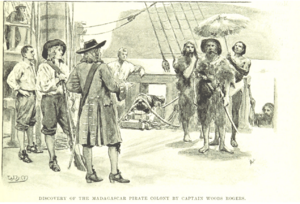Pirate haven facts for kids
Imagine a secret hideout where pirates could feel safe. These places were called pirate havens. They were like special ports or harbors where pirates could fix their ships, get new supplies, find more crew members, and spend their stolen treasures. They also used these havens to hide from navies and wait for merchant ships to pass by.
These havens were often in areas where the local governments were too weak or simply didn't care enough to stop piracy. This made it easy for pirates to operate freely. Some famous island strongholds included Tortuga in the Caribbean, Madagascar in the Indian Ocean, and the Sulu Archipelago in the South China Sea. Places like Barataria Bay and Port Royal also gave pirates and buccaneers a lot of freedom.
Contents
How Pirate Havens Changed the World
Pirate havens had a big effect on how trade and sea battles developed over time.
Stopping Trade and Business
Pirate havens allowed pirates to launch many attacks on ships carrying valuable goods. This caused big losses for traders. They had to pay more for insurance or avoid certain routes. Pirates often attacked ships from all nations. They stopped the flow of goods and people across the Atlantic Ocean. This ocean connected Europe, Africa, and the Americas.
Pirates stole valuable items like sugar, tobacco, spices, and gold. They also took ships and equipment needed for sailing. This made it harder for countries to trade.
Sometimes, people who bought and sold goods would buy stolen items from pirates. They paid less than they would have in a normal port. Pirates accepted this lower price. These dealers then sold the goods in regular ports. This created competition and changed prices for many products.
Some government officials even worked with pirates. For example, Charles Eden, the governor of North Carolina, pardoned famous pirates like Blackbeard (Edward Teach). He even let Blackbeard set up a pirate base. This made governments look weak and helped piracy grow.
Pirate Culture and Community
Pirate havens helped create the exciting pirate stories we know today. These places inspired many tales, songs, movies, and books about pirate adventures.
- Mixing Cultures: Pirate havens were home to many different kinds of people. They came from various backgrounds and cultures. This led to a rich mix of ideas, languages, and customs. People shared things and even created new ways of life.
- Religious Freedom: Unlike many parts of Europe at the time, pirate havens often allowed different religions. While Christianity was common, Muslims and Jews could often practice their faith freely.
- Fairness for All: Pirate communities often tried to be fairer than the societies their members came from. Things like how rich someone was or their family name mattered less. Many pirates followed a code that aimed for equal sharing of wealth and power.
- Making Their Own Rules: Some pirate havens governed themselves. Pirates would choose their leaders and make decisions together. This idea of democracy was very different from the kings and strict rulers in Europe.
- Fighting for Freedom: Pirate havens were often seen as places that stood up against powerful European nations. Pirates would rebel against the normal rules. These communities became symbols of freedom and independence.
What Made a Good Pirate Haven?
Pirate havens shared some common features that made them perfect for pirates.
- Good Geography: They usually had natural harbors or hidden coves. These spots offered protection from storms and a good view of approaching enemies. They were also near busy shipping lanes, making it easy to spot and attack merchant ships.
- Weak Governments: Often, these places were controlled by weak or corrupt governments. These governments either ignored piracy or even supported it. Some governments even encouraged piracy to hurt their rivals or to make money from taxes or bribes. Some havens even had their own rules and ways of settling arguments.
- Busy Trade Spots: Pirate havens were busy places for trade. Pirates could sell their stolen goods, buy supplies, hire new crew members, or share information.
- Community Life: Havens were places where pirates could find friends and feel like they belonged. They shared a similar lifestyle and values. This helped create a strong sense of identity and culture among pirates from different places.
Famous Pirate Havens Around the World
Barbary Coast Havens
The Barbary Coast in North Africa had many pirate havens. These included Salé, Algiers, and Tunis. From the 1500s to the 1800s, corsairs used these havens. They attacked European ships and captured thousands of people. The Pirate Republic of Salé in Morocco even made treaties with European governments.
Other important bases were Mehdya in Morocco and Ghar al Milh in Tunisia. The United States Navy was partly created to fight these Barbary pirates. The US fought two wars against them to protect its ships.
Ireland's Pirate Hideouts
In the early 1600s, places like Leamcon and Baltimore in southern Ireland were pirate strongholds. Ireland's coast had many good harbors, bays, and islands. These were perfect for hiding. Also, Ireland was far from London, making it hard for the government to control.
Madagascar: A Far-Off Base
The island of Madagascar, off the east coast of Africa, was a rumored pirate gathering spot. It was a perfect base for attacking ships from the Mughal Empire and the East India Companies. It was far away from any authority. Famous English pirate Henry Every gained huge wealth here. He was said to have settled on Madagascar.
Madagascar was a great place for pirates because it had plenty of food, water, and wood. Pirates even set up their own communities there. Some Madagascan pirate havens included Fort-Dauphin and Sainte-Marie.
A pirate colony was started by English and French pirates in 1698. They built a fort and a town near Sainte-Marie. They traded with the local people and raided passing ships. This colony lasted about 25 years before it was destroyed.
The Bahamas: New Providence
New Providence in the Bahamas became a pirate base in the early 1700s. Pirates found friendly merchants and even governors there. These people were willing to trade with pirates or protect them. Pirates also formed groups and alliances there, like the Flying Gang.
Modern Pirate Havens in Somalia
In the early 2000s, piracy became common off the coast of Somalia. Pirate havens at this time included Eyl and Harardhere. The government of Somalia was not able to enforce laws at sea. Other modern havens were Garaad and Hobyo.
More Pirate Haven Examples
- Barataria Bay in the United States
- Campeche in Mexico
- Crete in Greece
- Harardhere in Somalia
- Visby in Gotland, Sweden
- See Victual Brothers
Caribbean Havens
- Matanzas in Cuba
- Republic of Pirates (New Providence) in the Bahamas
- Port Royal in Jamaica
- Saint Thomas in the U.S. Virgin Islands
- Tortuga in Haiti
- Virgin Gorda in the British Virgin Islands
Legendary Havens
- Libertatia
Pirate Utopias
Some people believe pirate societies were like temporary places of freedom. They were outside the control of governments. In these places, pirates could briefly live by their own rules and ideas of freedom.
See also
- Tax haven




